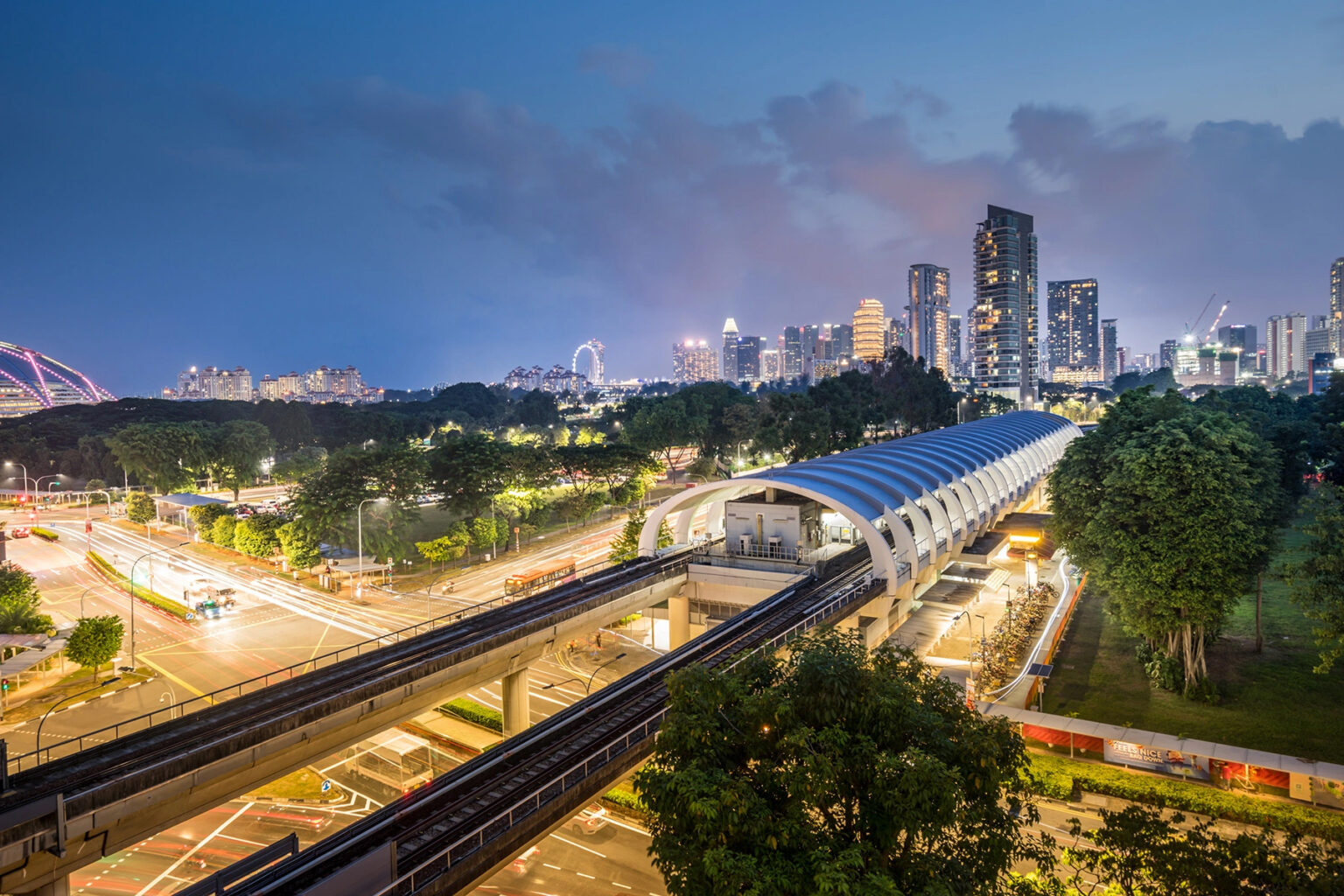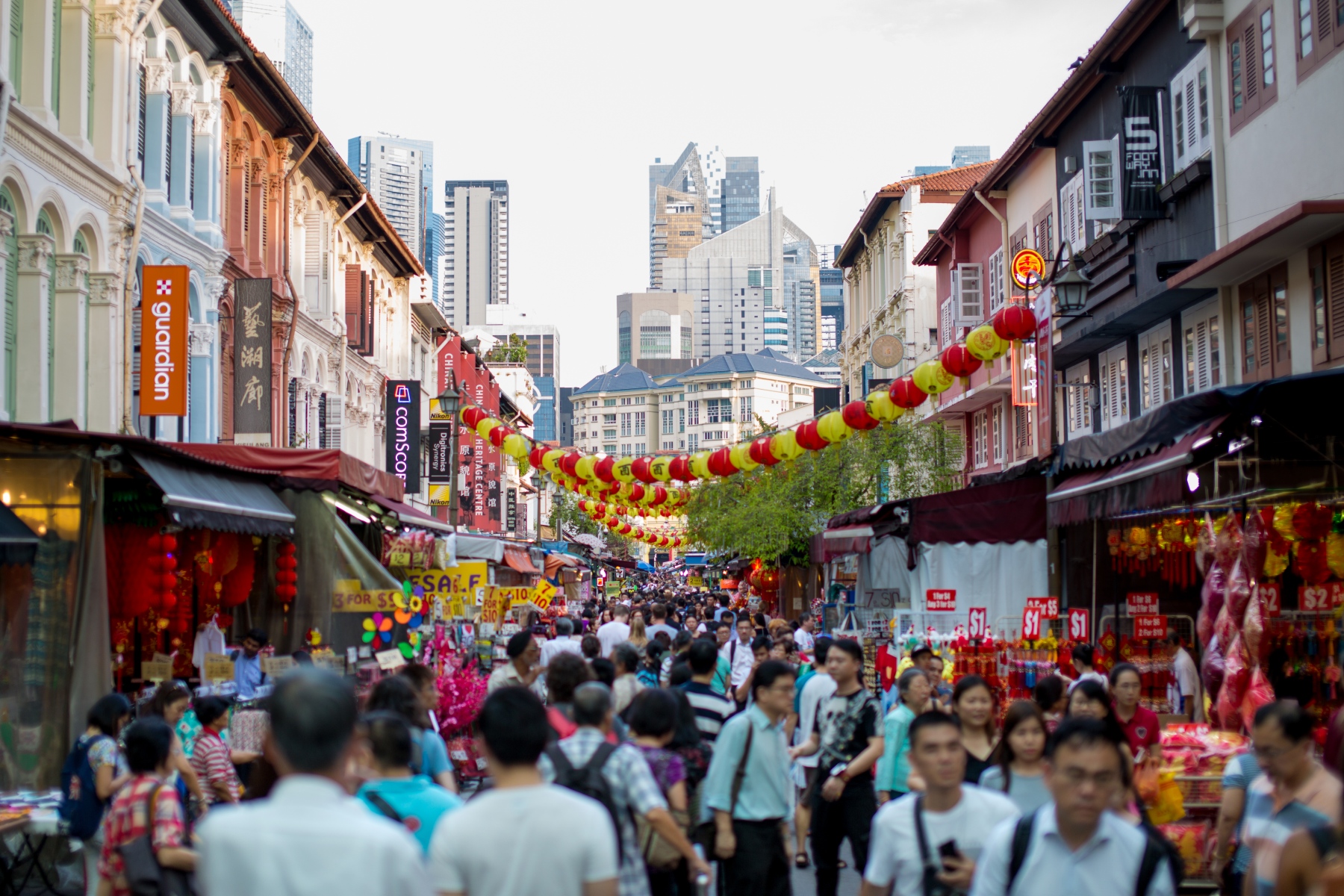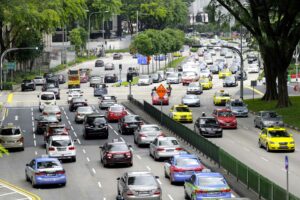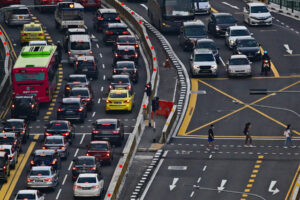Moving to a new city is exciting, but there is always a learning curve for new expats. One of the first challenges you’ll face is working out how to get from A to B.
Thankfully for newcomers, public transport in Singapore is among the best in the world, with a host of affordable options available. Whether you want to travel by train, take the scenic route with a bus, or explore further afield, there’s always a way.
Learn about the infrastructure and network with the following topics:
- What is public transport in Singapore like?
- Which public transport apps or websites are there in Singapore?
- Can you travel by train in Singapore?
- How do buses work in Singapore?
- Can you use taxis, Ubers, and other car services for transport in Singapore?
- Are there long-distance coaches in Singapore?
- Air travel and airports in Singapore
- What other methods of public transport are there in Singapore?
- Does Singapore offer any public transport discounts and financial aid?
- How disability-accessible is public transport in Singapore?
- How environmentally friendly is public transport in Singapore?
- Public transport safety tips in Singapore
- How do you complain about a public transport service in Singapore?
- Useful resources
What is public transport in Singapore like?
Public transport in Singapore consists of an incredibly clean, safe, modern, and comprehensive network. In fact, according to a recent study, it ranks fourth in the world after Hong Kong, Zurich, and Stockholm.
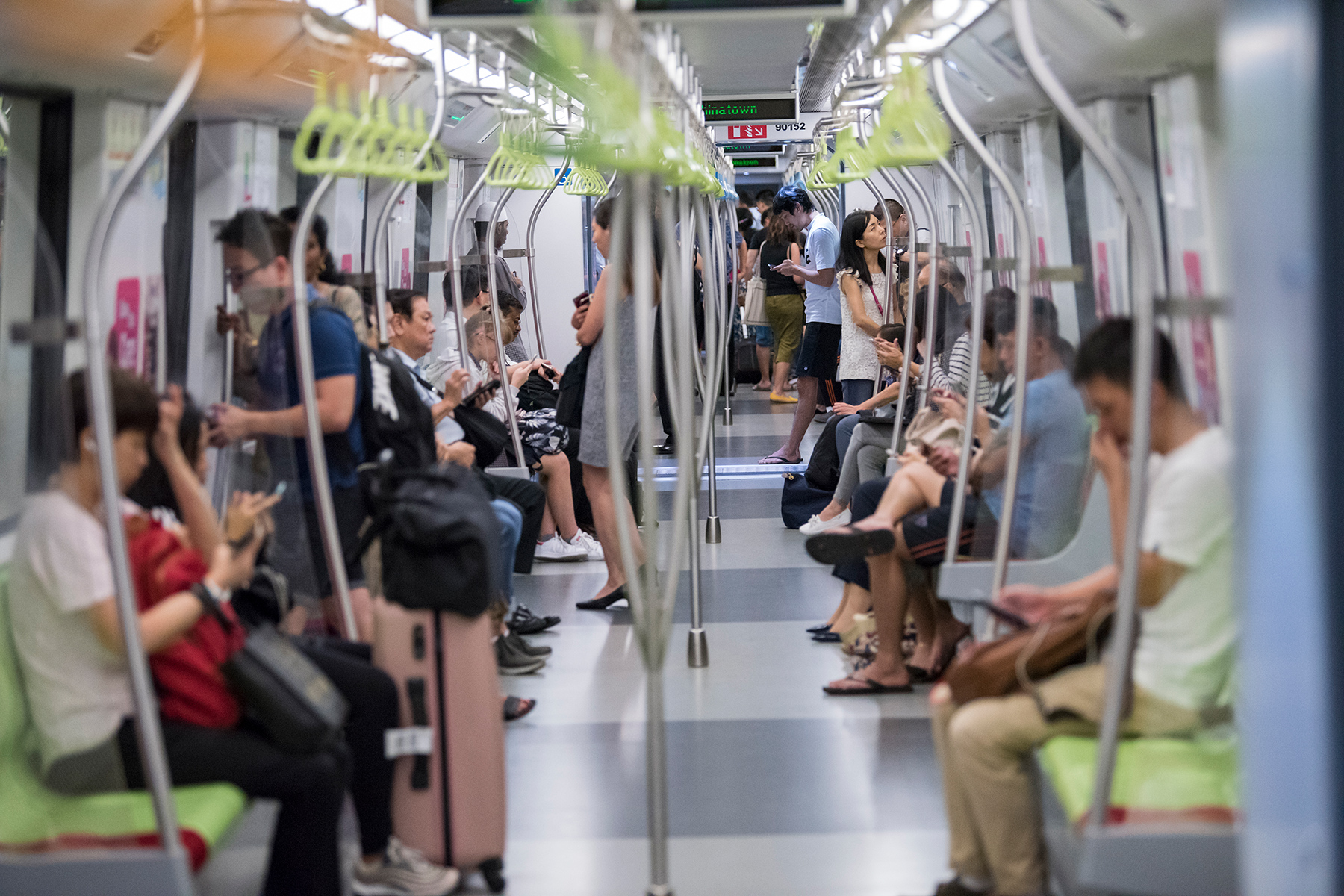
Singapore’s Ministry of Transport oversees all public transport infrastructure in the country through its subsidiary Land Transport Authority and Public Transport Council.
Internationals living in Singapore who do not plan to drive can easily zip around the island without a car. This is because the public transport options in Singapore include the urban Mass Rapid Transit (MRT) train system, an extensive bus network, and plenty of cabs and ride-hailing apps.
Because of the high cost of car ownership, most Singaporean residents choose to get around with these options. Indeed, nearly 6.4 million people use public transport each day, down from a pre-pandemic high of almost 7.7 million.
Ready to get moving? Just pick up an EZ-link card – or use your contactless card from a Singaporean bank – and you’re all set!
Which public transport apps or websites are there in Singapore?
Luckily, there are numerous websites and apps that can help you find your way around Singapore’s public transport system.
Whether you need to map a journey or find bus times, there are plenty of ways to plan your trip from your phone. Public transport apps in Singapore include:
- MyTransport (link to app stores in PDF): The official app of the Land Transport Authority has everything you need to get around. Get real-time bus and MRT departures, check fares for your journeys, find taxi numbers, and more.
- Singabus: This popular app draws accurate information from the Land Transport Authority to provide bus times and other up-to-date information. You can also save your favorite stations and stops for easy access. Download it from the App Store or Google Play.
- SG Buses: This handy app for bus users is available for Apple and Android. It provides information on timetables, fares, and more for Singapore’s four bus companies.
- Citymapper: A favorite of urban globetrotters, Citymapper is smart and user-friendly. It lets you set your preferences – from bus-only routes to journeys that minimize walking.
Can you travel by train in Singapore?
Singapore is home to the Mass Rapid Transit system (MRT), a railway that spans the entire city, making getting around a breeze. With over three million passengers each day, this system is the most popular option for public transport in Singapore. Its network of six lines and 140 stations is located above and below the ground.
Trains run regularly throughout the day, though the services shut down completely for a few hours at night. Missed a train? No worries – the next one will be along shortly, you can be sure of that!
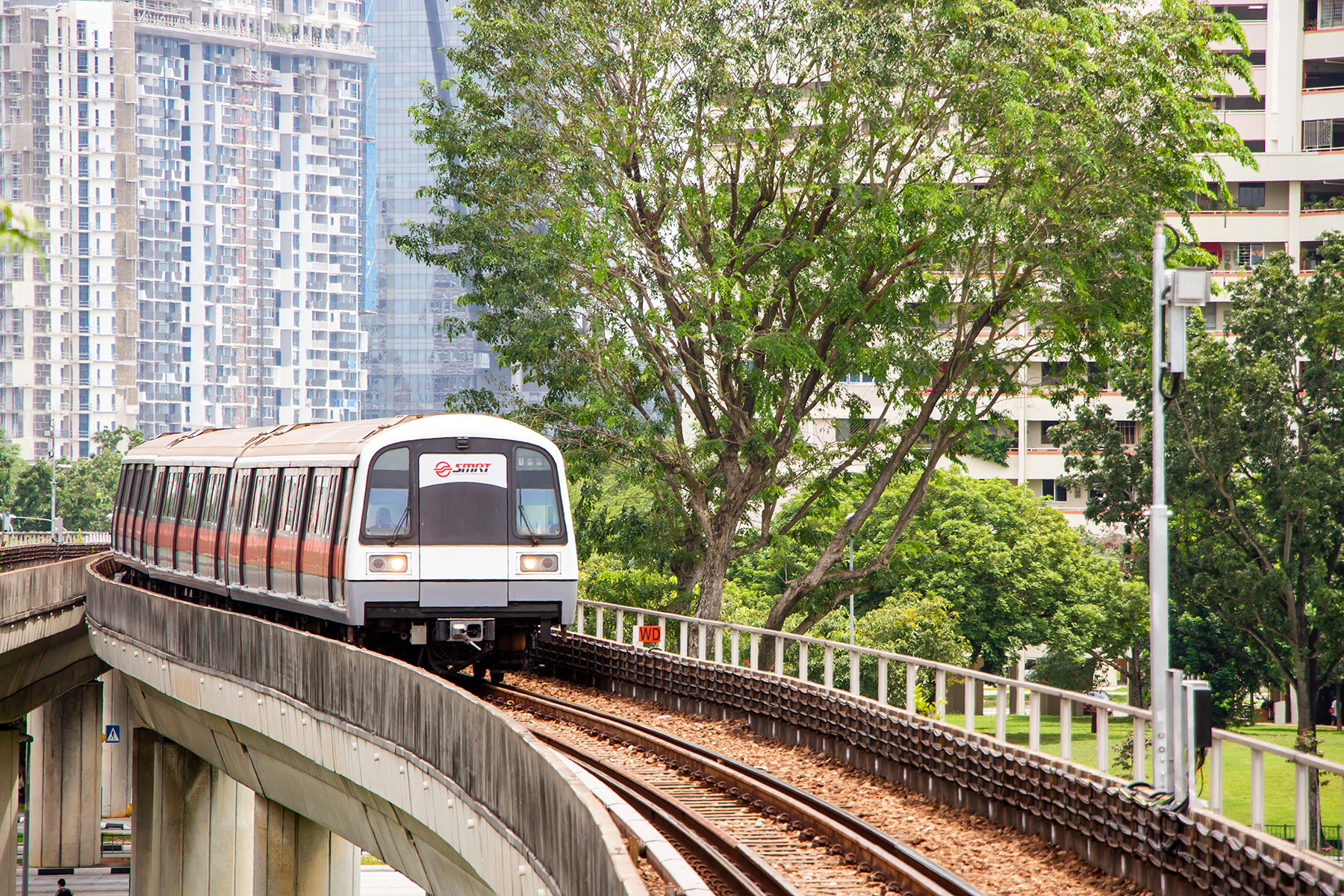
Because the MRT operates as an urban rail system, much like the London Underground or the New York Subway, facilities on board are generally limited. However, each car has priority seating for seniors, pregnant people, and those with mobility issues.
Be aware that certain restrictions apply onboard the MRT, and fines apply for rule-breaking. For example, you should not eat, drink, or smoke on trains. And, no matter how popular the pungent fruit is, durian is strictly prohibited.
How to buy a train ticket
Public transport in Singapore requires an EZ-link card, which you can buy and store credit on. This operates like London’s Oyster or Paris’ Navigo cards. You can purchase and top-up EZ-link cards at most stations or 7-Eleven stores. These cost S$10 and require a minimum of S$5 of stored value. There are also concession cards available for certain groups.
If you do not use the trains or buses regularly, you may choose to use your Singapore bank card instead. Just hold your contactless Visa or Mastercard – credit or debit is fine – or your mobile wallet to the reader as you pass through the MRT turnstiles and keep moving.
The exact price of an MRT trip varies because it depends on the length of the journey. The LTA has a fare calculator to work out the exact price of your trip.
Singapore takes fare evasion seriously and issues fines to those caught unawares. You can receive a penalty of S$50 for the following offenses:
- Not paying your fare
- Failing to tap in or out with your card
- Not using your concession card if applicable
- Having an invalid ticket
If you do not pay the fine, you might end up in court and have to pay S$1,000. This can go up to S$2,000 and include a six-month imprisonment for repeat offenders.
What time does the train service start and stop?
The MRT operates between 05:00 and midnight every day. However, in certain situations, such as on public holidays and festive occasions, this schedule may be extended.
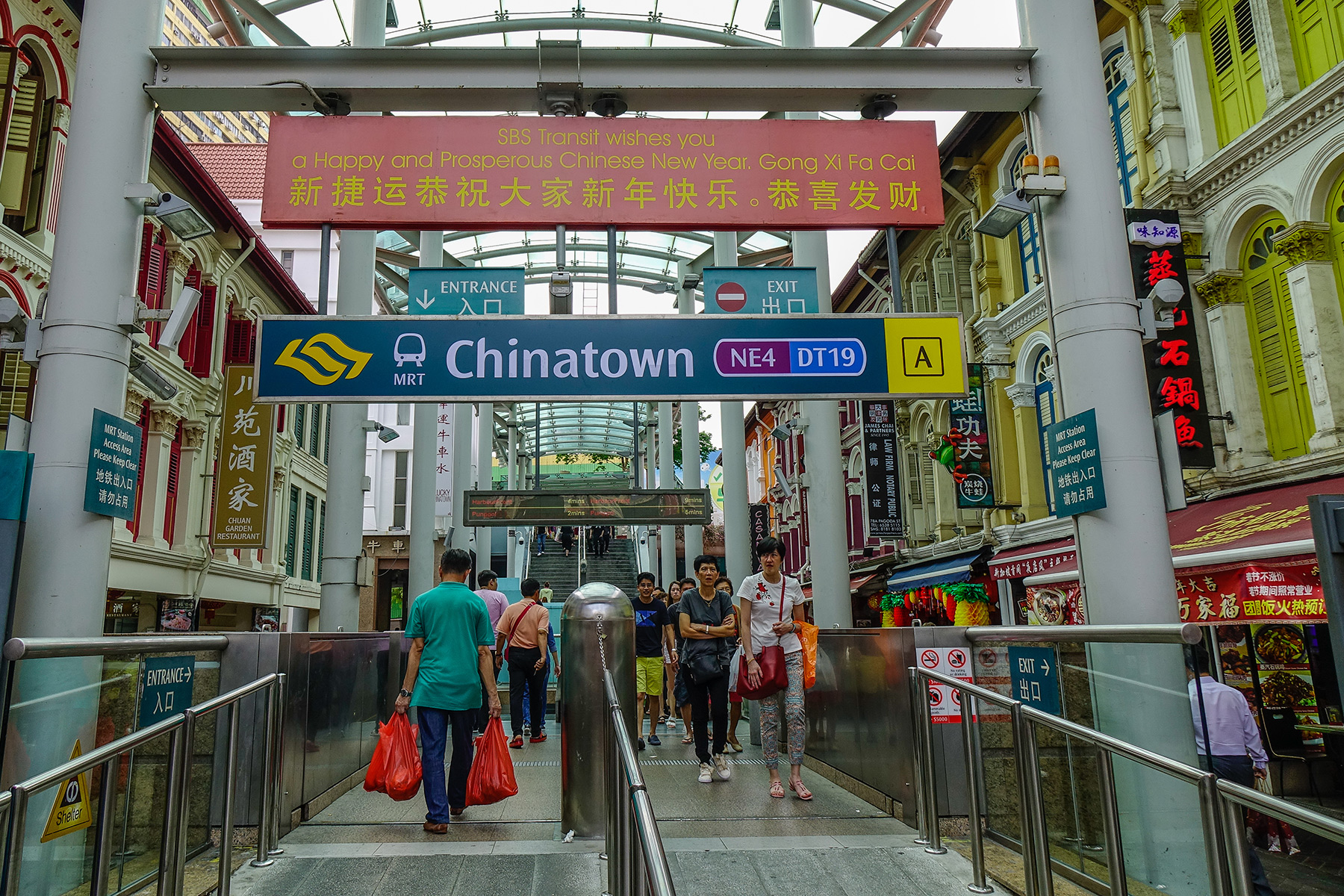
In general, MRT trains run every two or three minutes during rush hours (around 07:00–09:00 and 17:00–19:00) and every five to seven minutes at all other times.
If you need a map of the MRT system, you can usually get a hard copy at stations. However, it is much easier to access one online (PDF).
Train stations and stops
MRT stations in Singapore have a customer service desk and several ticketing machines. The larger ones have toilets, convenience stores, and other shops. Some also have taxi ranks or bus stations for onward journeys.
International trains
Because of Singapore’s high cost of living, some people choose to live in Malaysia and commute to Singapore for work. The main hub is Johor Bahru in Malaysia, and commuter trains run between the two cities. In general, though, Singapore does not operate international trains because of its geographic isolation as an island.
That said, for a once-in-a-lifetime experience, internationals might want to try Belmond’s Eastern & Oriental Express train, which runs between Singapore and Bangkok, Thailand. This exquisite train service operates multi-day journeys that recall the glamorous golden age of train travel.
How do buses work in Singapore?
Buses are also a popular choice for public transport in Singapore. Nearly 3.5 million people get around by bus every day. This is especially true in places that do not have MRT stations in easy walking distance.
There are four bus operators in the country. SBS Transit is the largest, with more than 3,400 buses and 200 services. Other bus companies include:
Like the MRT, buses in Singapore are clean, modern, and reliable. These urban buses have minimal facilities onboard – just card readers (to pay your fare!) and seats. However, most buses are now accessible for wheelchairs, and, thankfully, in such a warm climate, all feature air-con.
How much are bus fares in Singapore?
Singapore requires an EZ-link card or contactless debit or credit card for most public transport, including buses. Like the MRT, bus fares depend on how far you travel on each journey. You can use the LTA fare calculator to check the cost.
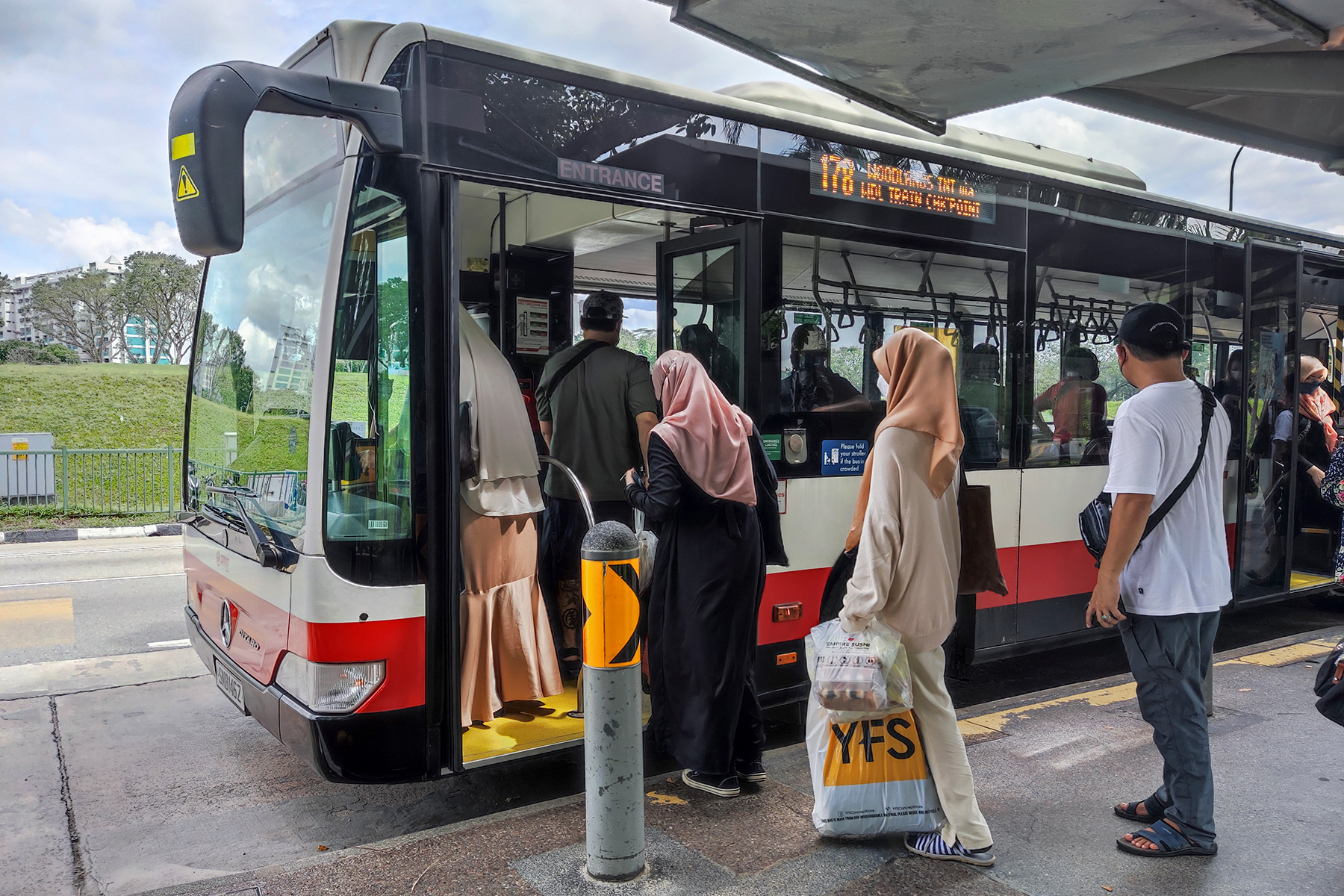
You simply board at the front of the bus and tap your card on the reader by the driver. When you leave the bus, do so from the rear door and tap your card on the reader on your way out. In a pinch, you can use coins to pay your fare – just ask the bus driver when you board.
As with the MRT, you can receive a fine for fare evasion on buses – the same penalties apply.
Bus timetables and maps
Like most public transport options in Singapore, buses in the country generally operate between 05:30 and midnight. However, some bus companies provide night services to get people home safely after a night out. If you need a map of bus routes, your best bet is to visit the website of the specific operator.
Bus stations and stops
Most local bus stops in Singapore are very simple – you will probably find some kind of shelter with seats, a route map, and a timetable. However, the big bus interchanges, such as those at Toh Payoh and Clementi, are much bigger and usually have toilets, convenience stores, and vending machines. You cannot buy EZ-link cards at bus stops, but bus interchanges usually have a customer service desk that sells them.
Can you use taxis, Ubers, and other car services for transport in Singapore?
If you want to get around by car without driving yourself, you’ll be pleased to know that Singapore is home to taxis and ride-hailing apps. Once again, the Land Transport Authority is responsible for these.
In keeping with other public transport in Singapore, taxis and ride-hailing cars are generally clean and well-maintained. Drivers are usually polite and speak English – along with at least one of the other official languages of Singapore – and like to play music on the radio during the ride.
There are six taxi companies in Singapore:
You can easily get a taxi through the company’s dedicated app, and booking in advance during rush hour is essential. However, you can also hail a cab on the street or at stands at malls, hotels, and other major landmarks.
The starting fare for a taxi ranges from S$3.90–5, depending on the cab type. After this, you will pay 24–36 cents per 350–400 meters. In addition, there are surcharges for peak hours, late nights, public holidays, and certain locations, such as Changi Airport and Marina Bay Sands. You can pay your fare by cash, card, or NETS (Singaporean electronic payment). The LTA provides full pricing details.
While Uber does not operate in Singapore, there are two ride-hailing apps that are very popular: Grab and Gojek. Both let you order a car on demand, and you can usually choose what type of vehicle you want.
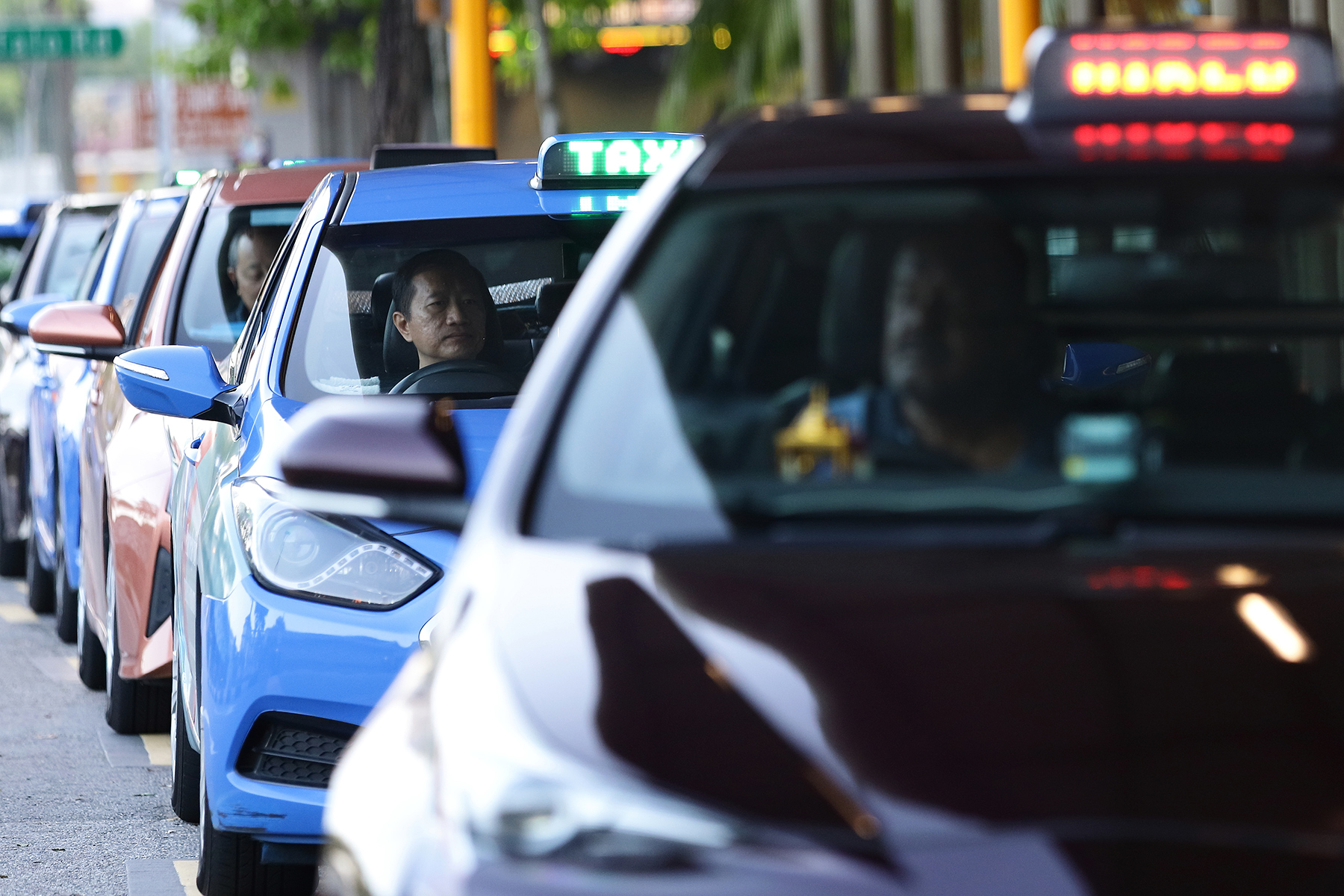
Like taxis, these apps use a base fare and then charge by distance, but you will see a price estimate before booking your ride. You can also pay through the app. When you arrive at your destination, just jump out – the app will take care of the fare.

Writer and local expert
Gayatri Bhaumik
Insider tip
You can also use Grab and Gojek to order food and pay for various things in Singapore!
Are there long-distance coaches in Singapore?
There are several long-distance bus operators in Singapore, and these run services to Malaysia. For example, buses can take you to popular Malaysian destinations such as Johor Bahru, Malacca, Kuala Lumpur, Genting Highlights, Cameron Highlands, and Penang. Below are some long-distance bus companies operating in Singapore:
- Golden Coach
- NICE
- Transnational
- Transtar
Air travel and airports in Singapore
Technically, there are two airports in Singapore: the award-winning Changi and the elite Seletar. However, Changi is the one that operates all the commercial flights, so it’s more likely to be the one you use.
Changi has four terminals servicing over 100 international airlines. At each one, there are all sorts of shops selling high-end designer fashion, duty-free cosmetics and alcohol, and books. You’ll also find plenty of restaurants, cafés, airline lounges, and entertainment options.
The airport’s main attraction is the Jewel, a massive mall that houses a plethora of shops, restaurants, and entertainment. It’s also home to the iconic HSBC Rain Vortex, the world’s largest indoor waterfall. Passengers on certain flights can also check their bags in and enjoy the mall before making their way to the appropriate terminal.
Of course, this is the official home of national flag carrier Singapore Airlines, which operates routes across the world. However, as the airport is a major international transit point, many other airlines fly here, including:
- Air China
- Air France
- Air India
- Air New Zealand
- British Airways
- Cathay Pacific
- Emirates
- Etihad
- Finnair, Jetstar, KLM, Qantas, Swiss, United, and Thai Airways,
Changi Airport is very easy to access. The MRT’s East-West (green) line goes straight from the airport to central Singapore, though lugging big suitcases on the train may be challenging. There are also buses to the city center, and you can also get a taxi or hail a ride on an app.

In Singapore’s northeast, Seletar Airport was a former base for the British Royal Air Force. Now, it is a civilian airport, though it is usually only used for private jets and business aviation.
What other methods of public transport are there in Singapore?
The LRT (Light Rail Transit), an extension of the MRT, is a smaller rail system operating in northeast Singapore. The system has 40 stations across two lines and sees over 200,000 passengers every day.
Singapore’s Tanah Merah Ferry Terminal also allows passengers to access ferry services to destinations in Indonesia and Malaysia. Popular spots include Batam, Desaru, Bintan, and Pinang.
Prefer to get around on two wheels? Singapore has a network of cycling paths that stretches across 440km. Furthermore, the government aims to triple this by 2023.
Does Singapore offer any public transport discounts and financial aid?
Certain groups of people will receive discounts for public transport in Singapore. This includes seniors, students, and children. For example, seniors and children under 0.9 meters tall and under the age of seven receive discounts on MRT fares. Seniors can get the Passion EZ-link card to access discounted fares.
There are also schemes for:
- Students
- People with disabilities
- Full-time National Servicemen
It is also possible to access discount fares by traveling in the morning before rush hour.
How disability-accessible is public transport in Singapore?
The powers that be are working hard to ensure that public transport in Singapore is accessible to all. All MRT and LRT stations are barrier-free, making them accessible to those with mobility issues, families, and the elderly. In addition, the MRT system uses Braille on staircases and ramps and a Hearing Enhancement System for commuters with hearing aids.
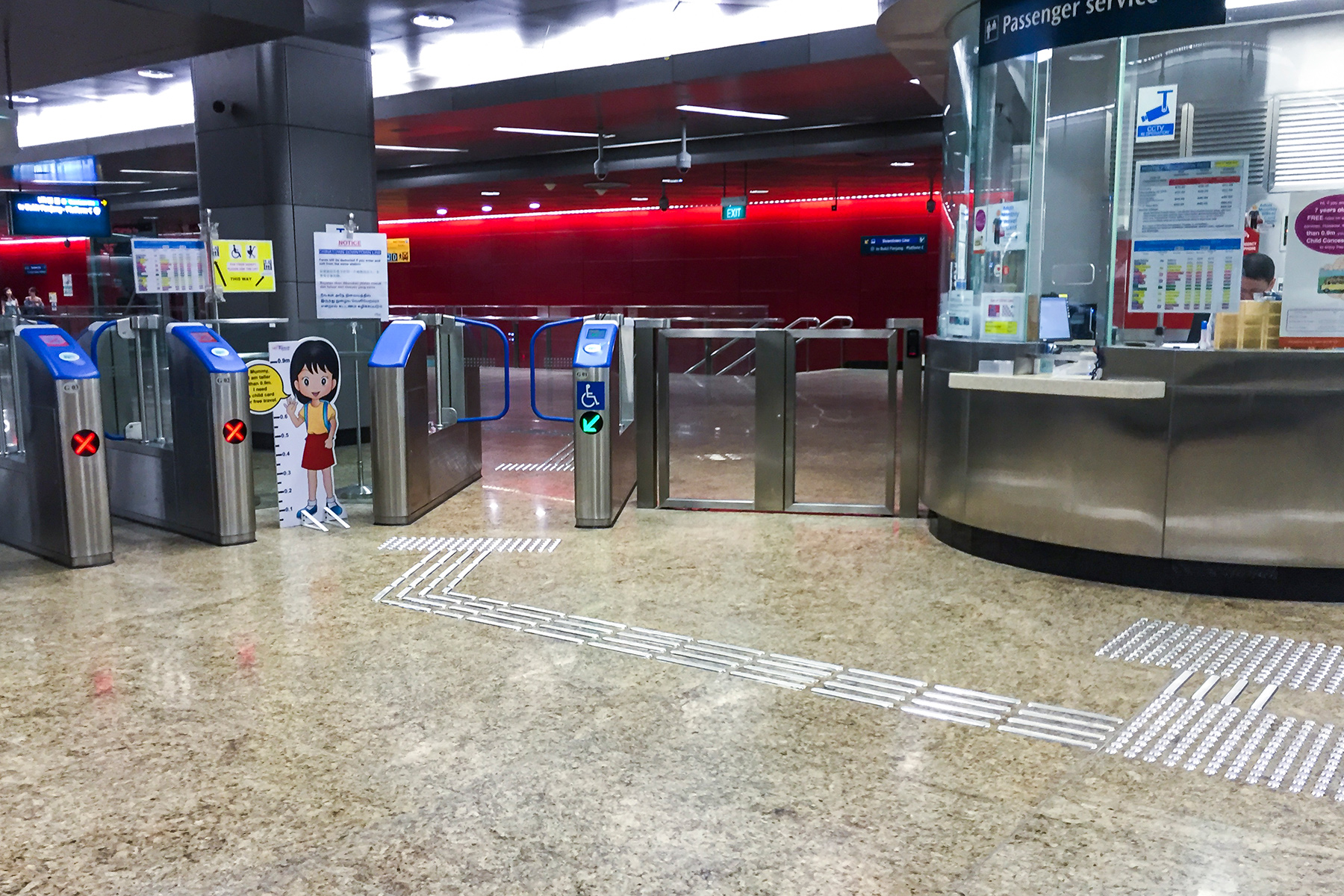
Most stations have ramps, lifts, wheelchair-accessible toilets, and wide turnstiles. Trains have two wheelchair-accessible carriages, too – you can find stickers on platforms where these are located.
In addition, all the big bus interchange stations and most bus stops are barrier-free. Public buses are also fully wheelchair accessible.
How environmentally friendly is public transport in Singapore?
Public transport in Singapore is becoming increasingly green. The country has already made some strides in an environmentally friendly direction, and there is plenty more to come. Under the Singapore Green Plan 2023, the aim is to get all cars to run on “cleaner energy” by 2040.
The country’s MRT and LRT stations also feature award-winning environmental design. The Circle and Downtown lines have received BCA Green Mark GoldPLUS certification for their sustainable features.
In addition, as of 2020, all new public buses are “cleaner energy” buses, meaning they are electric or hybrid. The plan is to replace all diesel buses with these by 2040.
To ensure a sustainable future, the government will also not register new diesel taxis from 2025 and require all new taxis to be “cleaner energy” models after 2030.
Public transport safety tips in Singapore
Singapore is a very safe country – it is the third-safest city in the world, according to The Economist (2021), so you’ll be able to move around without a care.
Public transport in Singapore is also very safe, though it is always wise to take common-sense precautions. Here are a few tips:
- Be aware of your surroundings.
- Keep your bags and belongings close to you.
- Avoid traveling in empty buses or train carriages.
How do you complain about a public transport service in Singapore?
If you need to file a complaint about public transport in Singapore, there are several options. It’s a good idea to start by contacting the service provider directly. For example, you can reach SMRT through the online feedback form or by calling them at 1800 336 8900.
However, if this does not resolve the issue, you can contact the Land Transport Authority via an online feedback form or by calling 1800 278 3500.
Useful resources
- SMRT Corporation – official site of Singapore’s MRT operator
- SBS Transit – major bus operator
- Land Transport Authority – government body overseeing public transport
- Ministry of Transport – government body for transport
- Getting Around Singapore – guide by Singapore Tourism Board
